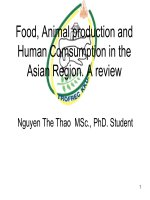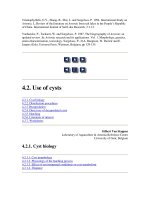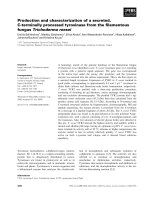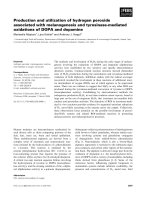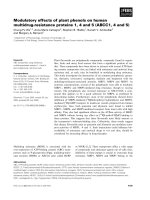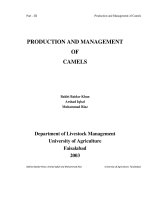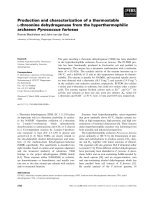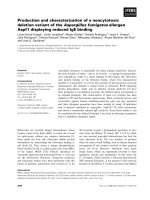coursera week 5 DAIRY PRODUCTION AND MANAGEMENT
Bạn đang xem bản rút gọn của tài liệu. Xem và tải ngay bản đầy đủ của tài liệu tại đây (163.51 KB, 66 trang )
Weaning - Removal of milk from the calf
Rumen Papillae - Projections from the lining of the rumen that allow for absorption of nutrients
Immunoglobulins - Transferred from the dam these are large proteins found in colostrum that are
important in providing immunity from diseases
Milk replacer - Dry feed that contains similar nutrients found in milk
First calf heifer - Heifer that is calving for the first time
Hello, this is Gabriella Varga.
And today we will talk about calf nutrition management from the time
the calf is born to being weaned off of milk.
Calf health, growth, and
productivity rely heavily on nutrition and management practices.
Every heifer calf born on a dairy farm represents an opportunity to maintain or
increase herd size, to improve the herd genetically, or
to improve economic returns to the farm.
The objectives of raising the newborn calf to weaning age are optimizing growth and
minimizing health problems.
In this video, we will discuss the development of the calf's digestive
system, learn how important colostrum is for
the immune system, and the nutrients the calf needs to be healthy and grow well.
From birth to about two weeks of age, the calf is a monogastric, or
a simple-stomached animal.
The abomasum is the only stomach compartment actively involved in
digestion, and milk or milk replacer provides the main nutrients for the calf.
Let's first get acquainted with the calf's anatomy.
At birth,
the calf's stomach contains the same four compartments found in adult ruminants.
However, the calves reticulum, rumen, and omasum are inactive and undeveloped.
The newborn's functional stomach, the abomasum is similar to a human stomach.
The objective of calf nutrition is to promote rumen development early in life so
that the calf becomes efficient in the absorption of nutrients and
has a much smoother transition at weaning.
So let's start at the beginning of the the calf's life, and
talk about how the calf can digest nutrients, such as those that are in milk.
At birth, the rumen has little tissue development and
lacks a population of microorganisms.
The calf depends mainly on its digestive enzymes,
released primarily from the abomasum and small intestine,
that help bring down the fats, non-fiber carbohydrates and protein.
In the young calf, some liquids can bypass the rumen, and
flow directly to the abomasum through the esophageal groove.
Calves are initially fed colostrum,
their mother's first milk after calving, for about three days after birth.
Within ten minutes, a liquid forms a clot in the abomasum due to enzymes and
hydrochloric acid acting on casein and fat in the milk.
Clotting binds much of the casein and fat into a clump, or a curd,
to be digested slowly by stomach enzymes over a period of 12 to 18 hours.
Curd development allows for limited meal feeding of calves,
compared to other continuous nursing species.
The fraction of milk that does not form a curd is called whey.
Whey is composed of water, minerals, lactose,
and other proteins, specifically, immunoglobulins.
Whey passes directly into the small intestine for
absorption and/or digestion within ten minutes after feeding.
From the small intestine,
immunoglobulins can be absorbed into the calf's bloodstream.
We will discuss the importance of immunoglobulins for
the calf in more detail later.
The lining of the rumen wall in an adult cow
has very pronounced covering of papillae.
These papillae are finger-like projections that greatly increase
the rumen surface area, the area through which nutrients can be absorbed.
Within a few days of birth, the calf's rumen becomes populated with microbes from
feed, the environment in a cow.
The papillae development is stimulated by the end products of
microbial fermentation.
Specifically butyric acid and to a lesser extent propionic acid.
There are two separate components to rumen development.
The first is the physical size of the organ.
By four weeks of age, if the calf is fed only milk, or
milk replacer, the rumen will be quite small.
As milk, or milk replacer, is fed in increasing amounts, the abomasum grows in
size, but the rumen remains proportionally small and grows only moderately.
The longer a calf is fed large amounts of liquid feed,
the greater the restriction on rumen growth relative to the size of the calf.
Lack of rumen development causes a slump in growth rates after weaning.
The second aspect of rumen development is the elongation
of those rumen papillae and the thickening of rumen walls.
Feeding management can drastically affect their development.
A calf fed grain, in addition to milk, shows a great deal more papillae
development and a much thicker, darker, and a more vascularized rumen wall.
Now, compare a third calf fed milk and good quality hay from three days of age.
Despite eating moderate amounts of hay,
the papillae are not developed at all and the rumen wall is quite thin.
This is because the digestion end-products of hay include more acetic acid,
which rumen walls do not use for papillae growth and development.
Calves with access to large amounts of roughage will have
a considerable increase on rumen size.
However, this is due largely to stretching,
not real growth of the rumen tissue.
Feeding calves the correct amount of high-quality colostrum
immediately after birth, plays a critical role in the health of the calf.
Colostrum, defined as milk removed from the mammary gland in
the first 24 hours after birth, contains immunoglobulins that,
when absorbed by the calf's gut, helps the calf to resist disease challenges.
Calves that receive adequate amounts and quality of colostrum,
grow better and are much healthier.
The immunoglobulins found in colostrum are large proteins.
Calves have openings in the small intestine to accommodate the proteins
absorptions, but these openings close shortly after birth.
Three types of immunoglobulins can be found in colostrum.
Immunoglobulin G makes up 70 to 80% of the immunoglobulins,
and helps identify and destroy invading pathogens.
Immunoglobulin M comprises 10 to 15% of immunoglobulins, and
serves as the first line of defense against infection.
And then finally, immunoglobulin A comprises the remaining 15% of
immunoglobulins in colostrum, and protects the mucosal surfaces,
such as the intestine, from invasive pathogenic bacteria.
Colostrum also contains vitamins, minerals, energy, and
proteins needed for calf metabolism, growth, and for
additional stimulation of the calf's immune system.
To make sure that the calf receives immunity from the dam,
colostrum management should focus on three factors immediately after birth.
How soon, how much, and the quality of the colostrum.
Colostrum should be fed within one hour after birth.
Approximately 35% of ingested immunoglobulins can be absorbed when
calves are fed colostrum immediately after birth.
But this declines to less than 5% absorption of
immunoglobulins when calves are fed 20 hours after birth.
Feed Colostrum at a rate of 12 to 15% of the calf's body weight.
Large breed calves, such as Holsteins weighing more than 90 pounds at birth,
can be fed four quarts at birth.
Feed calves weighing between 50 and 90 pounds,
such as Jerseys, three quarts at birth.
If possible, feed an additional two quarts to all calves 12 hours after birth.
Do not allow calves to suckle the dam to obtain colostrum.
Although, suckling does enhance absorption,
research has demonstrated that 25 to 40% of calves left with the dam
will not ingest enough colostrum to attain adequate levels of passive immunity.
Use high-quality colostrum.
Colostrum should have more than 50 grams per liter of immunoglobulins,
this equates to the green reading on a colostrometer.
A colostrometer measures the specific gravity of colostrum prior to feeding.
The quality of colostrum is determined by the amount.
If a cow produces more than 18 pounds of colostrum,
the odds are less than 50% that it will contain sufficient immunoglobulins.
Dry period length.
If a cow has a dry period of less than 45 days, often have poor quality colostrum,
as well as those animals that experienced poor nutrition or
heat stress during the dry period.
The breed.
Holsteins have poorer quality colostrum than other breeds.
Colostrum from Holsteins typically are lower in immunoglobulins than colostrum
from Jersey cows.
And then, the age of the cow.
Older cows tend to have more immunoglobulins than first calf heifers,
as they have been exposed to a greater number of pathogens.
Calf Nutrition and Management, Part 2
Share
0:00/7:11
Share
Help Us Translate
Interactive Transcript - Enable basic transcript mode by pressing the escape key
You may navigate through the transcript using tab. To save a note for a section of text press
CTRL + S. To expand your selection you may use CTRL + arrow key. You may contract your
selection using shift + CTRL + arrow key. For screen readers that are incompatible with using
arrow keys for shortcuts, you can replace them with the H J K L keys. Some screen readers may
require using CTRL in conjunction with the alt key
After a few days of colostrum feeding,
there are several liquid feeding options available.
These include whole milk, milk replacers, waste milk, and
fresh or fermented colostrum.
Any of these are excellent feed sources when available and
if it fits into the calf raising program.
Whole milk can be the primary liquid feed for calves, if it were dried whole milk
would contain 29 to 30% fat, 25 to 26% protein.
Whole milk will supply ample protein and energy for calves,
if one to two pounds is fed for every ten to twelve pounds of body weight.
However, due to its composition,
whole milk may be deficient in trace minerals and vitamins.
This can be remedied by feeding a quality calf starter
in addition to liquid feeding.
There are many excellent milking places available for calves.
Protein levels in milk replacers typically range from 18 to 22 percent.
New formulations designed for
intensive feeding programs contain 28 to 30 percent protein.
The main sources of energy in milk replacers are lactose and fat.
Lactose is the best source of carbohydrates, and
milk replacers generally contain 40 to 50% lactose.
Fat sources in milk replacers include lard, tallow,
stabilized greases, and hydrogenated vegetable oil.
Higher fat levels in milk replacers may decrease prevalence of scours.
Fat levels vary from 10 to 22 percent in milk replacers and in general.
So what do milk replacer with twenty percent fat?
Additional information on methods of calf feeding, colostrum quality and storage and
liquid feeding options can be found in the reading material for this lecture.
Calf managers should introduce dry feeds and
water to calves within 3 to 4 days of birth.
Feeding a commercial calf starter, or one mixed on the farm,
stimulates early rumen function and development, allows for earlier weaning,
and supplements the nutrition provided by the liquid feeding program.
Two starters that contain between 18 and 20% food protein.
And when selecting a calf starter, consider the following.
Physical form select whole coarsely ground cracked crushed roll steamed or
flaked textured grains.
The pallet quality, avoid pellets that are too hard or too soft.
Pallets at both extremes will affect intake and avoid fine particles.
And then consider molasses or molasses based products.
Which should be included at between 5 and 8% of the total mixture.
Begin offering starter at three days of age.
Calves should be eating some starter by five to seven days of age.
By the second week, calves should be consuming.
0.25 to 0.5 pounds per day at three weeks of age.
If free choice water is available calves will often double there dry
feed intake which coincides with a much more active vermin.
Water is critical nutrient for calves and
should be offered beginning at 3-4 days of age.
In order to digest feed rumen bacteria must have water.
Milk and milk replacer do not qualify as water since they bypass the rumen.
Calves should consume 8-10 quarts of water per day at weaning.
Weaning age varies from 4 to 8 weeks of age depending
on liquid feeding strategies.
Age, however, is not the primary criteria for weaning a calf.
Weaning decisions should be based on the dry feed intake of the calf.
When a calf consumes 1.3% to 1.5% of it's body weight as fry feed, it
is consuming enough nutrients to maintain it's weight, and grow without liquid feed.
For large breed calves this translates to weaning when the calf consumes 2 to
2.5 pounds of calf starter per day.
For three consecutive days.
For healthy calves, reduce liquid feed consumption by 50% per
day one week prior to desired weaning date to stimulate starter intake.
Once weaned, keep calves in individual housing for
approximately 7 to 14 days to observe calf health and feed intake.
Do not attempt to wean calves less than four weeks old.
After weaned from liquid feeds, calves should quickly consume between four and
five pounds of calf starter daily.
Calves may be moved to group housing at seven to eight weeks of age, or
one to two weeks after weaning.
During the first two to three weeks of group housing,
try to keep the ration the same as before weaning.
Post-weaning groups of four to six calves are preferable for
one to two months after weaning.
With good management, groups of eight to ten can work as well.
After weaning, begin incorporating good quality hay into the diet.
The general recommendation would be to wean calves at 5 to 8 weeks of age,
and offer hay starting at week 8.
Forage is important at promoting growth of the muscular layer of the rumen and
maintaining the health of the rumen epithelium.
Although research has shown that calves consume forages prior to weaning,
forages are not necessary until a time when a calf consumes four to
five pounds of high quality starter, which is typically after weaning.
Monitor starter consumption to ensure that hay is not being overeaten.
Fermented forages can be fed to calves.
But it is not recommended for calves less than three months of age.
Proper feeding and care of young calves is the first step in raising healthy,
productive replacement animals to enter the milking herd.
So in summary, feed four quarts of high-quality colostrum within the first
six hours to provide calves with essential nutrients and antibodies.
Match milk replacer to growth and weaning age goals to meet the calves' needs, and
to balance feed costs and animal performance.
Offer a palatable calf starter by three days of age to
stimulate rumen development and allow weaning by four to six weeks of age.
Provide calves with a clean, dry, draft-free housing that protects them from
harsh sun in the summer and cold winds in the winter.
From three days of age, make fresh, clean, free-choice water available, and
then work with your veterinarian to ensure that calves receive adequate vaccinations
Hello, my name is Gabriella Varga and I am Professor of Animal Science.
In this video we will be discussing the importance of heifer nutrition and
management from weaning to breeding.
We will discuss critical phases of growth for the dairy heifer, the importance of
good facilities, and how nutrition plays an important role in getting a healthy,
well grown heifer, ready to be bred, and prepared to have her first calf.
A number of factors go into meeting these goals.
The first of which is that Heifers must get off to a good start as calves.
That means good colostrum management and disease control.
We mentioned in our previous video that rumen development is critical.
So calves must be provided a good, palatable calf starter and
have access to fresh water.
Calves should be weaned after they have consumed two pounds of grain per day for
three consecutive days.
Holstein heifers should grow 1.7 to 1.9 lbs per
day before puberty, and should reach 85 to 90% of mature body
weight by calving, or a minimum of 1250 lbs,
to be able to achieve optimal first lactation milk production.
Age at first calving should be between 22 and
24 months of age to minimize heifer raising costs and
to maximize their production during the first lactation.
However, it is important to emphasize that heifers need to grow in height,
not just weight, because height is correlated with their frame size, and
can really impact risk for calving difficulties.
Therefore, heifers should reach a height at the withers between 51 to 55 inches
prior to calving.
After weaning, heifers really should be grouped by weight, not by age.
During this time it is important to monitor body weights, heights,
and body condition scores.
Weights obtained with a body weight tape around the heart girth
are reasonably accurate.
A body condition score of 3 on a 5 point scale is ideal.
Heifers at this age and
size should not have a lot of extra flesh around the rump area.
As indicated earlier, a good rate of growth for weaning to breeding
is over two pounds per day for the holstein or similarly sized breeds.
Let's look at some opportunities on the farm that will help make the transition
better for the heifer after weaning.
The following practices can really help reduce the stress placed on these heifers
during and after the weaning period.
A small-group housing facility for three to five calves should be used for
at least a month immediately after the postweaning period.
This postweaning area should be similar in housing type and
environment compared to the grow out facility and located in a similar area.
This allows for regular feeding and
observation of the two to three month old group, while feeding those younger calves.
Large super hutches, located adjacent to the calf hutch area, or
an open-front shed with an outside yard adjacent to the calf hutch area,
can be used in conjunction with small hutches.
Building with inside individual pens should also provide for
a group pen at least 12 by 12 feet for three to five calves.
Pens should always have a continuous supply of frost-free water.
At least 18 inches of bunk space should be provided for
each calf, with stanchions or dividers to define the eating positions.
When weaning time arrives the liquid feed portion of the young calves' diet
is reduced.
It is necessary to provide them a free choice grain mixture and
an ample supply of high quality forage.
To reduce the stress associated with weaning, calf starter is generally fed for
two to three weeks after weaning.
After weaning,
we should see calves with starter intakes between five to six pounds per day.
And this is the time we begin to feed a good quality forage.
Feed free choice high quality second or
third cutting mixed hay that is fine stemmed and mold free.
This can be a good quality grass or alfalfa or a mixture of these two.
Silage and pasture have generally not been recommended for
calves less than 400 pounds because it has been thought that the calf
cannot readily consume enough dry matter, in the form of wet forage.
High quality forage can comprise a significant amount
of the energy needed by the young heifer.
Grasses containing 14 to 16% crude protein,
and no more than 60% neutral detergent fiber can make up a significant part
of the heifer's diet before breeding, so long as that fiber is fairly digestible.
Corn silage can also make a portion of the heifer's diet, but the amount of grain fed
will depend very much upon the age of the animal and the forage quality.
Total mixed rations can also be fed to heifers after two months of age.
Feeding complete rations encourages the heifers to consume
several small meals during the day, and
leads to better digestion of feed and utilization of that feed.
The advantages of total mixed rations for these heifers are that
all the needed ingredients are in the desired proportions.
Time and labor are reduced.
And competition among animals is minimized.
The young heifer from weaning to six months of age is not capable of consuming
and fermenting large quantities of feed and forage, and
therefore does not produce large amounts of rumen microbial protein.
Therefore, at this age, protein is a nutrient that limits growth.
Heifers requires specific amount of protein daily.
And for heifers, total protein has been shown to the equally as important
as the various protein fractions.
So we want to balance primarily for crude and soluble protein.
14 to 15% crude protein for heifers before puberty
based on a 2.15% body weight dry matter intake per day.
About 13 to 14% crude protein after puberty for
heifers based on 1.65% body weight dry matter intake per day.
Maintain the ration at least at 30 to 35% soluble protein.
Rumen undegradable crude protein levels in excess of 25 to 30% are not required.
Use feed sources based on price and availability.
And not feed specifically designed for high bypass protein.
Young heifers with small rumen will respond with lean tissue growth
when they are fed a blend of high-quality protein sources.
Protein sources could be a blend of processed soybeans,
canola, corn proteins, and animal proteins.
It should be noted that large amounts of high-protein grasses or legumes
containing a lot of soluble protein and degradable protein are not recommended.
If such forages make up a large portion of the diets,
the heifer will not utilize all this protein.
And it will be wasted, and growth rates will not be optimal.
Heifers should be supplemented for vitamins and minerals according to their
needs based on the National Research Committee requirements.
Examples of diets for heifers from weaning
to post-breeding age are provided in the supplemental reading for this video.
From six months to breeding,
forages usually make up the majority of the ration.
Grain is supplemented to balance the ration for
the desired amount of daily gain.
Corn silage should be limited to no more than 50% of forage intake.
Excess energy during this period can hinder mammary development and
ultimately decrease the potential for milk production.
From breeding to calving forages should be maximized in the ration.
Feeding only enough concentrates to meet the animal's requirements.
Heifers should be started on the dry cow diet approximately 60 days prior to
freshening.
Specific information on feeding heifers prior to calving is provided in
the second dry cow video.
The energy requirement of the heifer will be influenced by the size, growth rate and
environment of the heifer.
There are two feeding strategies to meet the energy requirements of
growing dairy heifers.
First, diets can be formulated at variable energy densities and
fed free choice to allow the heifer to select her energy consumption.
In the second strategy, heifers' diets can be formulated at a fixed,
generally higher energy content and
precision-fed to specifically meet the heifers' energy requirement.
Regardless of feeding strategy, heifers should be fed to allow for
1.75 to 2 pounds of average daily gain or
approximately 130 kilocalories of metabolizable
energy per pound of metabolic weight.
During the time around puberty between 550 and 650 pounds for
large breeds, it is critical that heifers are not over fed energy.
The growth rate of the mammary system before puberty is much faster
than the growth rate of the body and the size of the mammary gland and
the ducts in the gland actually increase in size at this time.
Therefore, excessive energy intake prior to puberty can have
a negative effect on the mammary system and decreased subsequent milk production.
For large breed heifers, the optimum calving age is 22 to 24 months.
Smaller breeds that mature faster such as Jerseys, Airsures,
and Guranses can successfully calve at 22 to 23 months of age.
Production data research suggests calving heifers at 23 to 24
months of age is optimal for first lactation milk yields.
Dairy replacement heifers do have the potential
to calf at 19 to 20 months of age, which can lower raising costs.
However, heifers calving at young ages may experience calving difficulties,
metabolic disorder, and
have inconsistent lactation performance, which can really limit lifetime profit.
Calving dairy heifers at ages younger than 22 to 24 months
is possible but requires intensive management programs.
Hitting target body weights at calving is important,
as it helps reduce calving difficulties and
supports high levels of feed intake and milk production after calving.
For Holsteins, a post-calving weight of 1,250 pounds is ideal.
This table shows target body weights for
various breeds at different ages at first calving.
So in conclusion, in this video we discussed the critical phases of
the growth of the heifer, the importance of good facilities and
how nutrition plays an important role in getting a healthy well-grown
heifer ready to be bred and prepare to have her first calf.
Hello, my name is Gabriella Varga, and
I'm a professor of animal science from Pennsylvania State University.
We will be discussing feeding and
management of the dairy cow prior to calving.
In this first video, we will focus on the management and
general needs of the pregnant, non-lactating cow prior to calving.
Proper management and nutrition of the dairy cow transitioning into lactation is
very important for obtaining a healthy calf, increased reproductive efficiency
and optimal milk production in the following lactation.
These can be achieved by feeding balanced diets, providing good cow comfort and
insuring the cow is in good body condition before and after she calves.
We'll spend more time later discussing the importance of good body condition.
During the last six weeks before she stops lactating and gets ready to have her calf,
it is very important that the dairy cow is fed to meet her nutrient needs for
the level of milk produced.
The producer does not want the cow to gain body condition during
the end of her lactation that will get her too fat.
We try off the cow 50 to 60 days prior to calving to cause or
to switch nutrient use for milk production to growth of the calf within the uterus.
The fetus grows more during the last three months of gestation than any other time.
So therefore, all extra nutrients the cow consumes during the dry period
above her maintenance requirements go towards growth of the fetus.
A dry cow's nutritional needs are generally much lower than a lactating cow
because she's not using nutrients to maintain milk production.
The veterinarian and nutritionist help the producer in
assessing the body condition of their cows, are they too fat?
Are they too thin?
For example.
Body condition score is a subjective measure of subcutaneous
fat thickness, and a reflection of energy reserves.
When cows are to be dried off, so they stop lactating, they should be between
a body condition score of 3.25 to three five on a scale of one to five.
One being very thin, and five, extremely fat.
This next illustration shows a spectrum of condition scores of cows and
how cows can lose weight, and also gain weight.
Cows with proper body condition are less likely to have problems of calving.
The goal is for cows not to lose more than one condition score after calving.
Penn State and Cornell researches have demonstrated that cows with
body condition greater than 3.25 prepartem have greater risk of ketosis and
produce two to five pounds per day less milk the first three days of
milk than cows with a body condition score less than 3.25.
Feed intake of most cows decreases seven to ten days before calving.
Dry cows can be expected to have daily dry matter intake
equal to 2 to 2.2% of their body weight.
Therefore a 1350 cow would consume 27 to 37 pounds of dry matter each day.
However, cows that are over conditioned before they cab eat less before and
after calving with feed intake dropping sooner to a greater extent
before calving then optimally body conditions house ready to calve.
As a result, fatter cows mobilize body fat to a greater extent
compared to cows where feed intake is not compromised as greatly before calving.
This greater mobilization of body fat causes excessive fat
to accumulate in the liver of these cows, which further compromises
the liver's ability to make glucose to support milk production.
Thus, these cows have a higher likelihood of developing fatty liver and
then develop other diseases that might compromise their health after calving.
It is recommended that cows be managed to modify body condition later in lactation
and achieve the desired calving body condition score at that time,
rather than during the dry period.
If cows are becoming too heavy in late lactation,
the energy content of the diet should be reduced at that time.
Dry cows should be housed in an area where they can be observed easily and
moved to the maternity pen when presenting signs of calving.
Dry cows need a minimum of 24 inches of feed bump space per cow, but
preferably 30 inches.
When feed bunk space is limiting, cows eat less dry matter or eat larger and
fewer meals.
Therefore, stocking density is recommended to be no greater than 80 to 85%.
During this time frame cows naturally have a lower immune function and
are more susceptible to infection such as mastitis and neuritis.
Limiting the resting space increases the time cows spend standing and predisposes
them to hoof issues and increased incidence of lameness after calving.
To reduce stress, stocking rates should be near 80% of the capacity of
free stall barns, with a minimum of 100 square feet recommended per cow,
and 120 square feet for the maternity pen.
Heifers compete better with other heifers and have higher dry matter intakes and
longer resting times when housed separately from mature cows.
This may be in facilities such as a bedded pack, free stall, and out on pasture.
Cows are social creatures and establish a social hierarchy of boss and
subordinate calves.
Minimize the number of pen movements or addition of cows to the group
to minimize the amount of social upheaval that occurs with these new additions.
If herd size allows Cows should remain in the same
group throughout the last 30 days prior to calving.
For herds where this is not possible, new cows should be added
no more frequently than once weekly to the close-up dry cow group.
It has been shown in research trials that dry cows benefit from good heat
abatement management.
Heat stress decreases feed in take and results in greater metabolic disease and
lower milk production therefore providing fans and
sprinklers to cool cows is critical during the dry period.
Water quality and availability is critical for all cows.
Generally, four to five pounds of water ar required per pound of dry matter consumed.
On average, dry cows require about 13 to 15 gallons of water per day.
There are many strategies that work for feeding dry cows.
Whether it is a high fiber diet that is low in energy with hay or straw.
The goal should always be to provide high quality feed sources,
consistent availability of feed, adequate bunk space, and a comfortable environment.
In our next video, we will discuss in more detail specifics of feeding dry cows.
So in conclusion, for optimal management of the dry cow,
make sure cows are in proper body condition before dry-off.
Manage cows so no more than 10% are too fat or too thin.
Fat cows eat less, produce less milk the first 30 days in milk, and
have greater health problems, and generally take longer to breed back.
Make sure cows are comfortable.
Provide a minimum of 100 square foot per cow, or
11 square meters per cow in dry cow and calving areas.
Provide a minimum of 24 inches per cow of bunk space.
30 inches per cow is best.
Provide adequate high quality water.
Good quality forages, and feeds to ensure cow eat well.
Thank you for listening to this discussion on dry cow management.
Our next video in this series will focus on the nutritional needs of the dry cow.
Hello again, this video continues our discussion on management of the dairy cow.
We will focus on the nutritional needs of the pregnant, non-lactating cow.
There are many feeding strategies that would work for feeding dry cows,
however the goal should always be to provide high quality feed sources,
consistent availability of feed, adequate bunk space, and a comfortable environment.
Dry cows may be fed in two or one group feeding system.
What is a two group system?
It's the most common dry cow program.
The dry period is 60 days in length, and
the cows are split into a far-off group, 60 to 21 days prior to calving.
And a close-up group, 21 days to calving.
And the diet is formulated specifically for each group.
So how are far-off cows fed?
Well, the diet to these cows will consist primarily of forages such as corn silage,
straw, grass, hay, and some combination of silage.
Diets fed to the far-off group can be of lower energy density than
those given to the close-up group, because we are trying to control
the level of energy supplied, in order to prevent the cows from getting too fat.
So what is best for a close-up group?
The goal of this phase is to increase the nutrient density of the diet
to prepare the cows for lactation.
This diet has an energy level intermediate between that
of the far off dry cow diet, and the fresh cow lactating
diet approximately 0.7 Mcal of NE/lb of dry matter.
The advantages of this feeding program are,
to improve energy balance and liver function around the time of calving.
To aid the rumen in adaptation to the lactating diet, and
to provide adequate energy as dry matter intake decreases prior to calving.
However it does mean that cows have to move more often from pen to pen,
more rations have to be mixed increasing labor and feed costs, and
may overfeed energy and provide less rumen fill at calving.
So that's the two group system, what is a one group system?
Well, cows are all housed as one group, fed the same diet for
the whole length of the dry period.
Much of the focus in close-up rations
has centered on the energy density of the diets.
According to the 2001 Dairy Nutrient Requirement for
dairy cattle, a 1,500 pound cow in the last few weeks prior to calving
would only require 15 Mcal of NE/L per day.
If that cow consumes 28 pounds of dry matter,
the energy density of the ration would only
need to be 0.53 Mcal of NEL lactation per pound of dry matter.
By not feeding energy in excess of requirements, it is thought that the cow
will be at lower risk for the development of metabolic diseases post calving.
Advantages of a one group dry cow system.
The number of times cow moves are reduced every time a cow is moved,
she will be stressed especially over her new pen mates.
This stress can reduce intake, cause more metabolic problems, and
elevate fat mobilization.
This eliminates the problem of early calving cows being moved from one
pen to another, and put into a close-up diet only a week prior to calving.
It also reduces the number of ration changes and mixes, and
this lower in cost when cow's transition from the dry period to the milking ration,
it is a low energy diet.
0.6 metcals, NEL per pound of dry matter,
provides room and fill around the time of calving.
However, because of higher fiber may be less palatable,
especially if poor quality forages were fed and or, because of straw usage.
Straw or dry hay must be processed to less than two inches in length or
sorting will occur resulting in poor cow performance.
In addition, feeding a low potassium and calcium diet
will help to improve calcium homeostasis preventing hypocalcemia.
The bottom like for feeding dry cows, either one of these feeding systems
can work depending on the management of the farm, and
will be determined primarily by availability of facilities and labor.
How is the cow different in her nutrient needs when she's not lactating and
pregnant, compared to when she is lactating?
Since the cow is not making milk,
she still has to maintain her normal nutritional needs.
During the 60 days prior to calving,
her nutritional needs increase because she's carrying a calf.
Therefore she needs to have adequate energy to supply glucose to the calf,
as well as her bodily functions.
Protein is critical at this time as this nutrient is needed for
the calf to properly grow in utero, and for
the cow to prepare her mammary gland to start making milk.
Vitamins and minerals are critical in all stages of the cow's life.
However, prior to calving there are tremendous physiological demands on her
body, especially for calcium for milk production, muscle tone,
and helping to expel the fetus.
Now we will discuss in more detail, the major nutritional needs of the cow
during the few months prior to having her calf.
It's important to make sure that cows are comfortable, have adequate bunk space
to allow them to eat the nutrients they need on a daily basis.
Cows reduce their intake seven to 10 days prior to calving, so it is critical
that they can eat all the nutrients they receive in their daily ration.
The reason for the intake depression may include changes in hormonal status,
ketones in the blood that increase as the cow begins to use body fat,
immune suppression, and perhaps, a large calf inside the cow.
The nutrients that are important during the dry period
that we will discuss include energy, protein, and vitamins and minerals.
We will start our discussion of the nutrient needs of the dry cow with energy.
During the dry period,
the energy needs of the cow differ from those during lactation.
The cow no longer needs energy to produce milk, however she still needs energy for
maintenance, pregnancy, walking, and to maintain her body condition.
There is a high nutritional demand for fetal growth.
60% of the fetal growth occurs the last two months of gestation.
If sufficient nutrients such as energy are not provided in the diet
in adequate amounts, they will be drawn from the cow's body.
So we want to make sure there are adequate glucose precursors in the diet,
such as starch and sugar.
When the cow's not lactating, she is eating about
half the amount of dry matter she would normally consume when she is lactating,
therefore we really need to make sure that the energy density of the diet is adequate
to meet the needs of the growing microbes to make microbial protein.
In addition, nutrients are needed to maintain
good growth, such that their absorptive capacity is
ready to meet the demands of the increase in dry matter intake after calving.
We also have to remember that the gut tissues and
the liver are not working as hard during the dry period.
So we need to make sure they are prepared to increase in size and
workload, prior to calving with adequate energy sources in the diet.
Therefore including as many of the feed ingredients and the ration precalving,
as she will receive post calving will allow for the rumen bacteria, [INAUDIBLE],
to go through adaptation before the demand for milk production comes.
This can be achieved in both of the feeding programs we discussed earlier.
Energy concentration also needs to be higher for first calf
heifers because of their lower intakes and extra energy needed for growth.
Dietary protein quality and
quantity are also important for the success of the dry cow feeding program.
Underfeeding protein may lead to suppressed immune function, and
decreased availability of carrier proteins needed for efficient metabolism.
As the cow gets closer to calving, the calves needs for glucose and
amino acids also increase.
If the cow is short on protein, she begins to mobilize muscle tissue and
we do not want to deplete her maternal protein reserves that she will need for
making milk.
Protein are also important for good hormonal status.
Total blood protein decreases as the cow approaches calving.
This is because the calf is taking more of the protein, and
at the same time the cow is eating less.
The high demand for glucose at the initiation of lactation
cause another wrinkle in the cow's protein status.
Thus her body's protein in the form of skeletal muscle, is mobilized for
glucose production.
Therefore, good quality protein sources that provide the essential amino acid
needs of the cow, are critical in the dry cow feeding program.
Heifers require more crude protein in the diet than mature cows.
This is due to the lower feed intakes,
and higher protein requirements to accommodate their growth.
Although it appears that cows could be fed diets with less than 12% crude protein,
for the majority of the pre fresh transition period.
This is not recommended since it is believed that 12% crude protein
is the minimum needed to maximize fiber digestion and
microbial protein synthesis in the rumen.
Because the drop in feed intake accelerates as calving approaches,
the need for greater percentage crude protein in the diet also accelerates.
So crude protein requirements for mammal development are not trivial, and
increase crude protein need in the diets by 1 to 2 percentage units.
If cows and heifers are intermingled and fed the same diet prepartum,
the diet should be formulated to meet the needs of the heifers.
If they are housed separately, then separate diets could be formulated for
each group.
Considering additional requirements for mamic growth,
heifers need approximately a 1000 grams of metabolizable protein per day.
This is the protein that is actually absorbed by the intestine of the cow.
This is equivalent to 1400 grams of crude protein.
Cows need approximately 860 grams of metabolizable protein per day.
It is best to make measurements of dry matter intake on the farm so
that percentage crude protein in the diet can be calculated.
Providing adequate amounts of minerals and vitamins to the dry cow
is necessary to minimize health problems around freshening time.
Calcium, potassium, magnesium are critical in the prevention of many metabolic
problems that occur after calving.
Adequate amounts of calcium, selenium, vitamin a and e, iodine,
copper are necessary to prevent problems with the cow retaining her placenta
in her uterus after she gives birth.
Copper, zinc, selenium, and vitamins A and
E all play a role improving a cow's immune response.
Feeding adequate amounts of minerals and vitamins during the dry period is
necessary to give the cow the best chance to fight off many diseases.
In an upcoming video, Doctor Van Saun will discuss metabolic diseases of dairy cows.
And nutrients, such as vitamins and minerals,
that help in the prevention of these diseases.
In conclusion, for optimal nutrition of close-up dry cows, to benefit the health
of the cow and her calf, it is important to maximize dry matter intake,
minimize cow movements and overcrowding, provide adequate energy,
protein, vitamins and minerals and expose transition cows to
the same feeds that she will receive in the lactating ration.
Thank you and in our next video we will discuss calf feeding and management
Week 5
Latest Submission Grade
86.66%
1.
Question 1
Rumen size and papillae development are greatest before weaning when calves are fed:
1 / 1 point
Milk only
Hay only
Milk and grain
All of the above
Correct
2.
Question 2
Colostrum should be fed within how many hours after birth:
1 / 1 point
one
six
twelve
Correct
3.
Question 3
Colostrum quality is determined by:
1 / 1 point
Quantity
Dry period length
Breed
Age of cow
All of the above
Correct
4.
Question 4
After weaning heifers should be grouped by:
1 / 1 point
height
weight
body condition
none of the above
Correct
5.
Question 5
For large breed heifers age at freshening should be between:
1 / 1 point
19-20 months
22-24 months
Greater than 25 months
none of the above
Correct
6.
Question 6
Dry cows need a minimum of feed bunk space during the dry period:
1 / 1 point
24 inches (60 cm)
30 inches (76 cm)
None of the above
Correct
7.
Question 7
A two-group feeding system for dry cows includes:
0 / 1 point
60 day dry period
A far-off and close-up group
One diet for all cows
60 day dry period and a far-off and close-up group
Incorrect
8.
Question 8
Advantages of a one-group dry cow feeding system include:
1 / 1 point
Cows are moved many times
Increases the number of ration changes
Increases the incidence of early calving
Provides rumen fill around the time of calving
Correct
9.
Question 9
Dry cows reduce their intake prior to calving:
1 / 1 point
Due to inadequate bunk space
Overcrowding
Poor quality forage in the ration
They are too fat
All of the above
Correct
10.
Question 10
Compared to mature cows heifers having their first calf, energy and protein concentrations in the
diet need to be:
1 / 1 point
Higher
Lower
Correct
11.
Question 11
Total blood protein decreases as the cow approaches calving because:
0 / 1 point
The calf is taking more protein at the same time the cow is eating less
There is a lower demand for glucose as lactation starts
Skeletal muscle is mobilized from the dam for glucose production
The calf is taking more protein at the same time the cow is eating less and skeletal muscle is
mobilized from the dam for glucose production
Incorrect
12.
Question 12
Considering additional requirements for mammary growth, heifers need approximately how
many grams of metabolizable protein:
1 / 1 point
500 grams
700 grams
1000 grams
Correct
13.
Question 13
Under feeding protein during the dry period:
1 / 1 point
Will lead to an increased immune function
Greater incidence of metabolic diseases after calving
Reduces the amount of amino acids required by the fetus and mammary gland
Greater incidence of metabolic diseases after calving and reduces the amount of amino acids
required by the fetus and mammary gland
Correct
14.
Question 14
A successful dry cow program includes:
1 / 1 point
Making sure cows are eating well
Minimizing cow movements and overcrowding
Providing adequate energy, protein and vitamins and minerals
Exposing cows to the same feed ingredients that are in the lactating cow ration
All of the above
Correct
15.
Question 15
Cows that are fat during the dry period:
1 / 1 point
Will lose more body condition after calving
Make less milk after calving
Have greater risk of ketosis after calving
Eat less than thin cows
All of the above
Correct
Cai sữa - Loại bỏ sữa từ bê
Nhú dạ cỏ - Hình chiếu từ lớp lót của dạ cỏ cho phép hấp thụ các chất dinh dưỡng
Immunoglobulin - Được chuyển từ đập này là những protein lớn được tìm thấy trong sữa non,
rất quan trọng trong việc cung cấp khả năng miễn dịch khỏi bệnh tật
Chất thay thế sữa - Thức ăn khơ có chứa các chất dinh dưỡng tương tự có trong sữa
Bị cái hậu bị đẻ lần đầu - Bò cái tơ đang đẻ lần đầu
Xin chào, đây là Gabriella Varga.
Và hôm nay chúng ta sẽ nói về việc quản lý dinh dưỡng cho bê từ khi
con bê được sinh ra để cai sữa.
Sức khỏe của bê, sự phát triển và
